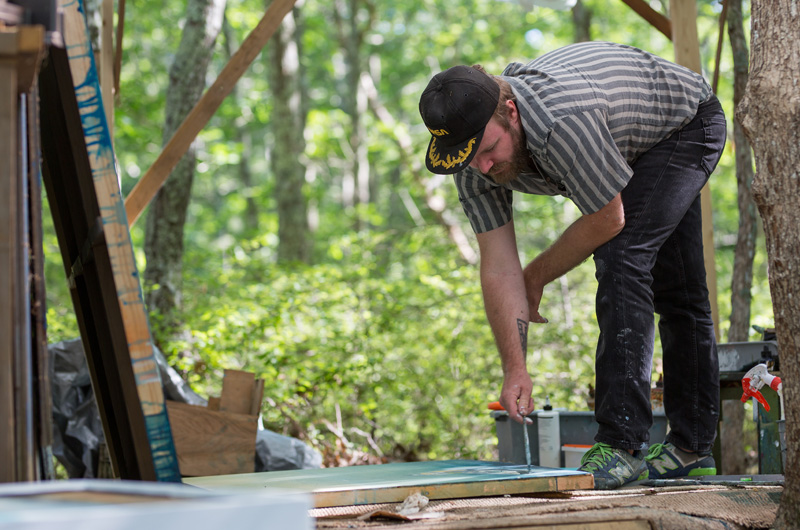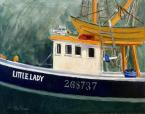Colin Ruel paints under a tarp attached to a shed in the woods of West Tisbury, a short walk down from the yurt where he lives with his wife and son. On large slabs of wood he uses water and acrylics to paint sea and landscapes, haunted by a sense of foreboding.
The edges of colors and shapes are hazy and blurred, softened by blown out water. Drips are part of the process, adding dimension from afar, an abstract nature up close. Occasionally a realistic point of focus, be it his grandfather’s boat, a horse or a house emerges starkly from the amorphous background.
A selection of his paintings will be displayed at the Field Gallery, kicking off the season with an opening on July 9 from 5 to 7 p.m.
The 33-year-old self-taught artist was born in Menemsha, growing up in a finished attic in house on a hill overlooking the water. He and his brother would play on boats, pretending to harpoon swordfish. In the winter, they were the only children there.
“It was pretty desolate,” he remembered. “And windy, always wind.”
He drew a lot, but was focused more on music than art. In his early 20s, he was asked to do some posters for events at Che’s Lounge in Vineyard Haven. He used whatever was at hand, crayons, pens, markers, a flower he had picked, and would do about three posters a week.
“I was really quick about it and didn’t think anything and they were really insane posters,” he said. “I didn’t understand that I was doing art really.”
Then he was invited to be in a pop-up gallery show. But he continued to focus on music, playing guitar and touring with Willy Mason and Nina Violet. Shortly after Che’s Lounge closed, he moved to New York city, planning to play music. He took a job at Pies ‘n’ Thighs, a fried chicken and pie place in Williamsburg, Brooklyn where many Vineyarders worked. Mr. Ruel was a busboy.
“I’ve never been paid so little in my entire life and paid so much rent in my entire life,” he said. “It was like I was bailing a boat with a hole and saying, look I’m sailing.”
It was a turning point that would direct him back toward art. After a quick trip back to the Island to build a stone wall for some cash, he found a job as an artist assistant for sculptor Alexander Calder’s grandson, Holton Rower.
It was under the direction of Mr. Rower that Mr. Ruel learned color. It was also one of the most stressful and odd jobs he’s ever taken.
“My first day, he gave me the most impossible task,” Mr. Ruel said. The task included covering a 60x60 piece of red plywood with quarter-sized drops of paint in a grid that went from white to dark blue. The paint was in ketchup bottles.
“It looked cool at the end, but it wasn’t straight, I did my best,” Mr. Ruel said. “He came down, he looked at it, he took a paint squeegee and squeegeed it onto the floor and said, ‘You wasted a lot of time and a lot of money, now pick that up.’”
He also had to lay out rotting cow skulls which Mr. Rower then raked up, only to be laid out again. It was grueling work in an art factory type setting, from which Mr. Ruel took away a relentless work ethic.
“I didn’t know anything about painting, I didn’t know anything about art, I didn’t take any art classes in high school or anything, but I went in,” he said. He stayed with it for two years, and then got a job doing restoration work for the Calder Foundation.
“I don’t know why they put me on these sculptures, because I didn’t know anything,” he said. “But I did good job on one, so then I started working over there.”
He then went to work for an art restoration company, Alchemy Paintworks, doing paint finishing for several different artists. There, he learned about precision.
“Everything had to be perfect, which I’m not,” he said. “It was better for me because I am naturally sloppy.”
After his day jobs in the art world, Mr. Ruel would go home to his railroad apartment and paint in the corner. Soon he had shows on the Island and in New York. Then he reached a landmark: he was able to rent a studio.
“It was like, okay, I can afford to rent a studio plus this apartment, where before I couldn’t even eat the cheap pizza on the way home,” he said.
For seven years, he and his wife, jeweler Nettie Kent, lived and worked in New York (they moved back to the Vineyard full time this past February). He painted abstract, kaleidoscope pieces that took color theory from Holton Rower and precision from Alchemy Paintworks. He featured bright colors reminiscent of past decades — Mattel toy company, Sunday morning cartoons and roller blades. For a long time he was hesitant to paint sea or landscapes.
“Being in New York . . . I couldn’t find a way to do it,” he said. “I just didn’t have it yet.” He wanted to paint in an honest way, a way that was rooted in history. Eventually he turned to the mythology of his grandfather, James Morgan, a folk artist and fisherman. Mr. Ruel began to explore the land and sea with a “New England apocalyptic vibe,” painting with the weight of worries both specific to the Island and general for the nation on his mind.
His tools included spray bottles, the hose, a hair dryer, fans, wedges and brushes with long handles. In his work, there are layers of paint, some of which allow the grain of the board to show through, others of which stand out from the wood like a barnacle on the side of a ship. He works from photographs, but deviates easily and often.
“I just want to paint how it feels, not how it looks,” he said.
A large painting leaned against the side of his art shed. Up close it is a series of earthen splotches and drips, layers of translucent color. From afar, it’s the curve of the beach and the eruption of the dunes of Lambert’s Cove. He was working to finish the painting before his Field Gallery show.
“It’s almost like growing a painting, rather than painting a painting,” he said.
Colin Ruel’s work will be displayed alongside photographer Jhenn Whatt’s new collection at the Field Gallery. An opening reception is Sunday, July 9 from 5 p.m. to 7 p.m.








Comments (1)
Comments
Comment policy »